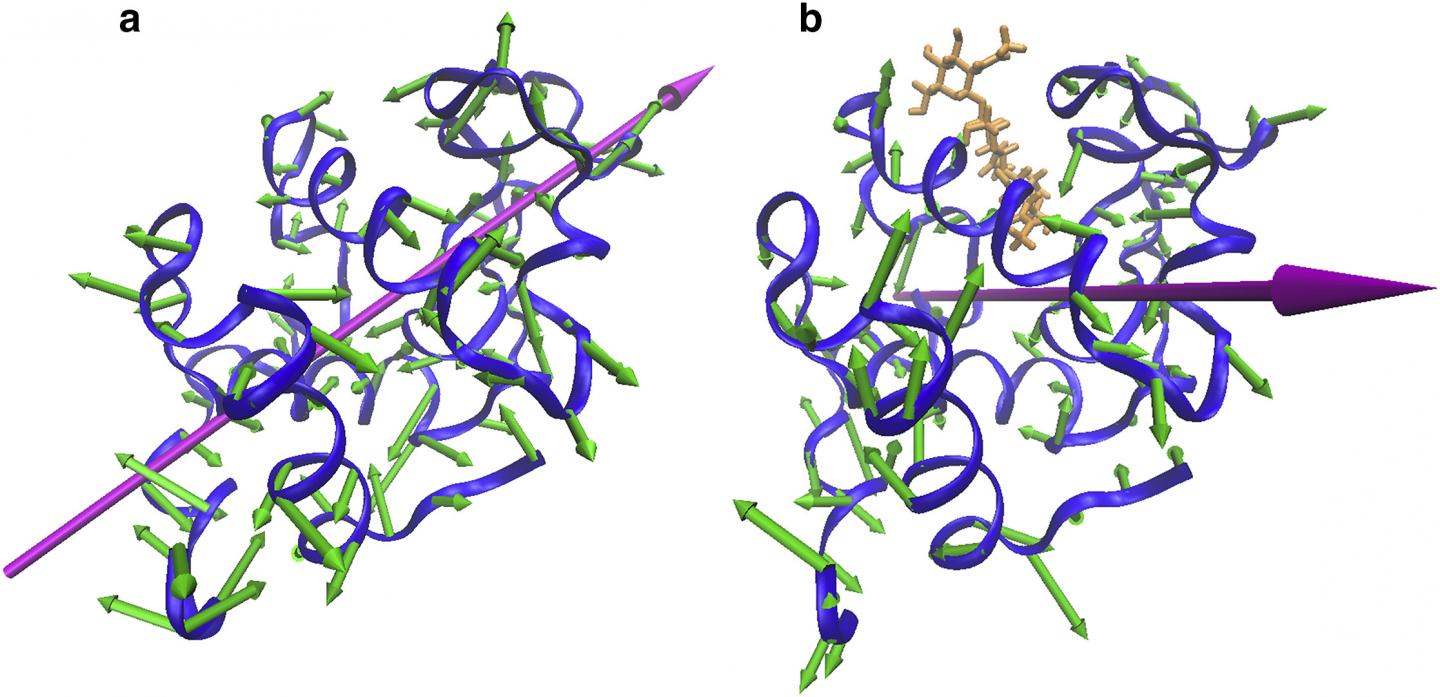
Credit: Reprinted with permission of Biophysical Journal.
BUFFALO, N.Y. — At every moment inside the human body, a carefully choreographed dance is being performed.
Proteins shake their bodies and wave their limbs, all with the goal of optimizing their interaction with other molecules, including other proteins. These tiny motions, called vibrations, enable the molecules to change shape quickly to bind to one another, which in turn facilitates tasks like absorbing oxygen and repairing cells.
The body's efficiency at performing these functions depends on how well proteins can interact.
But what makes one protein a better suitor than another?
A new study sheds light on this question, showing that in this biological courtship, dance moves matter.
"In the past, research on protein vibrations focused a lot on the energy of those vibrations," says lead scientist Andrea Markelz, PhD, a professor of physics in the University at Buffalo College of Arts and Sciences. "But what we found is that the direction of motion seems to matter more. The direction of motion — the direction in which different parts of the protein are moving — can really determine how well a protein performs its biological function."
The findings help to lay a foundation for the development of drugs targeting molecular vibrations. Such pharmaceuticals would block proteins from carrying out tasks that contribute to disease.
"We conducted the research using a new technique we developed called anisotropic terahertz microscopy (ATM), which reveals how nature exploits protein motions to improve efficiency. We can then optimize these motions for medicine and biotechnology," says first author Katherine Niessen, a UB PhD candidate in physics.
The research, published on March 14 in Biophysical Journal, was conducted by UB, the University of Perugia in Italy, and Hauptman-Woodward Medical Research Institute. It was funded by the National Science Foundation (NSF).
Foxtrot or tango?
The study focused on the chicken egg white lysozyme, a protein found in egg whites.
As a first step in their project, the scientists compared the regular vibrations of the lysozyme to the vibrations of the lysozyme when it was bound to a molecule whose presence blocked the protein from carrying out its usual biological duties.
What the scientists saw was that the free and inhibited lysozymes vibrated at similar energies, but with distinct directions of motion: The free lysozyme fluttered with a hinge-like flapping action — like the wings of a butterfly — while the inhibited lysozyme moved in a more scissor-like pattern.
"The result was a fundamental change from the conventional view. The vibrations changed their direction, even as the energy of the motions stayed the same," Markelz says. (She adds that as an analogy, this is akin to two people performing different dances — the foxtrot and tango, for instance — but exerting the same amount of energy.)
The same dynamic emerged when the team compared the regular lysozyme to a mutant chicken egg white lysozyme that was more effective at performing its job. The mutant and normal lysozymes had the same vibrational energies, but different vibrational directions.
A turnkey instrument for measuring vibrations
Research on molecular vibrations could open new avenues for drug development and artificial energy harvesting (the vibrations may explain why photosynthesis is so efficient). But historically, the tiny pulses and palpitations within proteins have been very hard to study.
Markelz is hoping to change that by developing a turnkey instrument that scientists around the world can use to research the vibrations.
To study the chicken egg white lysozyme, her team employed the ATM technique that her research group developed in-house. Unlike other methods used to research protein vibrations, ATM enables scientists to observe not only vibrational energies, but also the direction of motions.
The NSF recently awarded Markelz a nearly $400,000 grant to commercialize an easy-to-use ATM instrument, which would expand the capacity of the scientific community to explore molecular vibrations. The device would represent a great advance over other existing methods, which provide only a coarse overview of the vibrations and require extremely dry and cold environments and expensive facilities, Markelz says.
###
Media Contact
Cory Nealon
[email protected]
716-645-4614
@UBNewsSource
http://www.buffalo.edu
############
Story Source: Materials provided by Scienmag





